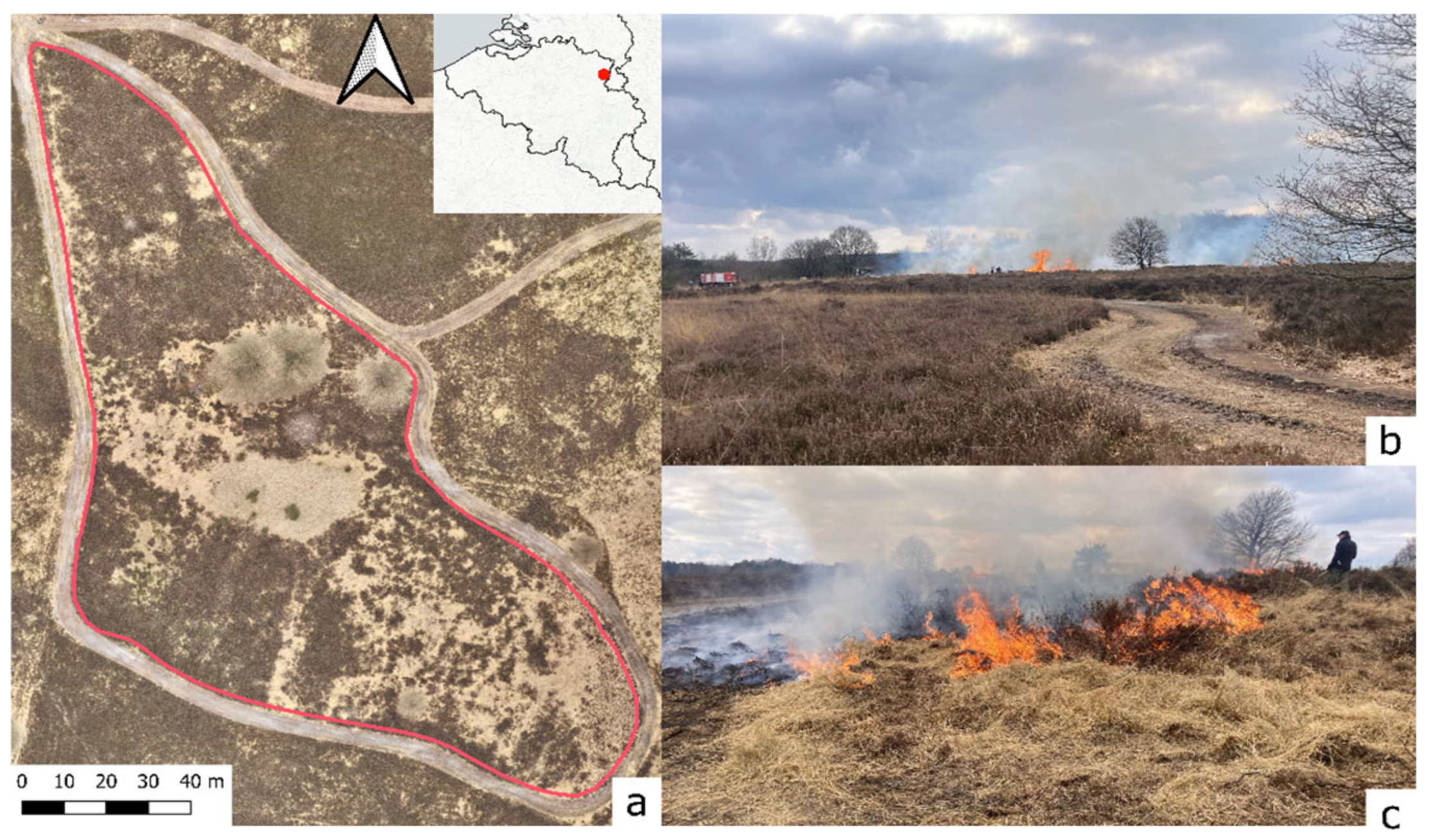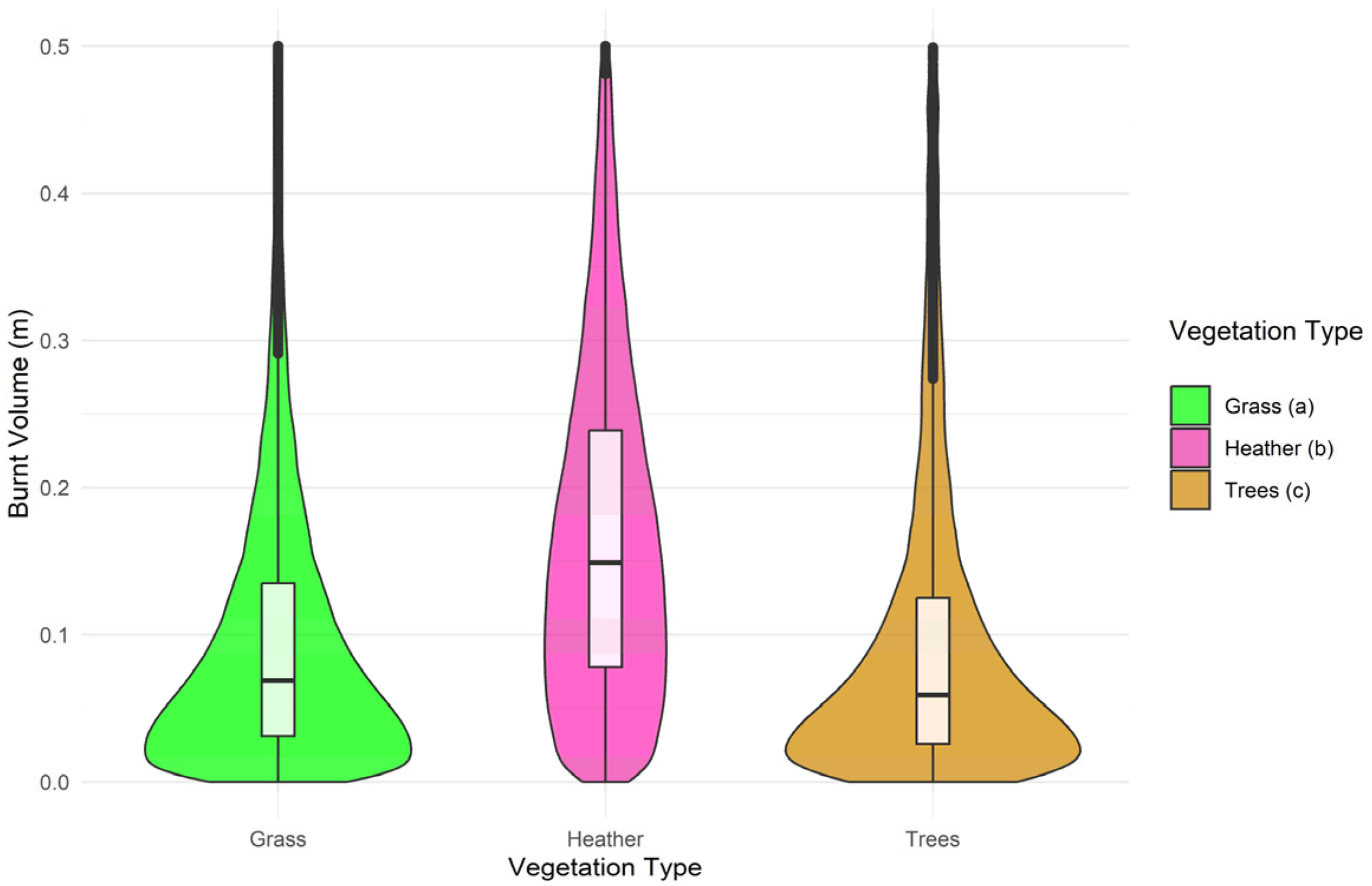Estimation of Burned Fuel Volumes in Heathland Ecosystems Using Multitemporal UAV LiDAR and Superpixel Classification
Abstract
Highlights
- UAV LiDAR allows us to distinguish between different fuel types and associated fuel consumption rates.
- Fuel consumption rates of heather vegetation were significantly higher than those of nearby grass vegetation.
- Such accurate and spatially explicit quantification can support the development of vegetation-specific prescribed burning protocols.
- These results can be used to support the integration of prescribed burning in overall wildfire management.
Abstract
1. Introduction
2. Materials and Methods
2.1. Study Area
2.2. Prescribed Burning Operation
2.3. Initial Data Processing
2.4. Height Difference Calculation and Quality Control
2.5. Fuel Type Classification Using Superpixel Analysis
2.6. Statistical Analysis
3. Results
3.1. Superpixel Generation and Vegetation Classification
3.2. Classification Accuracy Assessment
3.3. Spatial Distribution of Vegetation Types
3.4. Burnt Volume Analysis
3.5. Data Quality Considerations
4. Discussion
4.1. Effectiveness of Superpixel-Based Vegetation Classification
4.2. LiDAR-Based Fuel Consumption Assessment
4.3. Methodological Considerations and Data Quality
4.4. Implications for Fire Management in Heathland Ecosystems
4.5. Broader Implications and Applications
5. Conclusions
Author Contributions
Funding
Data Availability Statement
Acknowledgments
Conflicts of Interest
References
- Elmqvist, T.; Valkó, O.; Stoof, C.; Akala, T.; Arianoutsou, M.; Arsava, K.; Ascoli, D.; Bengtsson, J.; Castro, R.; Engelbrecht, J.; et al. Changing Wildfires: Policy Options for a Fire-Literate and Fire-Adapted Europe; EASAC Secretariat: Vienna, Austria, 2025. [Google Scholar]
- Pausas, J.G.; Keeley, J.E. Wildfires and Global Change. Front. Ecol. Environ. 2021, 19, 387–395. [Google Scholar] [CrossRef]
- Moreira, F.; Viedma, O.; Arianoutsou, M.; Curt, T.; Koutsias, N.; Rigolot, E.; Barbati, A.; Corona, P.; Vaz, P.; Xanthopoulos, G.; et al. Landscape—Wildfire Interactions in Southern Europe: Implications for Landscape Management. J. Environ. Manage 2011, 92, 2389–2402. [Google Scholar] [CrossRef]
- San-Miguel-Ayanz, J.; Durrant, T.; Boca, R.; Libertà, G.; Branco, A.; de Rigo, D.; Ferrari, D.; Maianti, P.; Vivancos, T.A.; Oom, D.; et al. Forest Fires in Europe, Middle East and North Africa 2018; Publications Office of the European Union: Luxembourg, 2019; ISBN 9789276112334. [Google Scholar]
- Stoof, C.R.; Kettridge, N. Living with Fire and the Need for Diversity. Earth’s Futur. 2022, 10, e2021EF002528. [Google Scholar] [CrossRef]
- Smith, B.M.; Carpenter, D.; Holland, J.; Andruszko, F.; Gathorne-Hardy, A.; Eggleton, P. Resolving a Heated Debate: The Utility of Prescribed Burning as a Management Tool for Biodiversity on Lowland Heath. J. Appl. Ecol. 2023, 60, 2040–2051. [Google Scholar] [CrossRef]
- Valkó, O.; Török, P.; Deák, B.; Tóthmérész, B. Review: Prospects and Limitations of Prescribed Burning as a Management Tool in European Grasslands. Basic Appl. Ecol. 2014, 15, 26–33. [Google Scholar] [CrossRef]
- Eames, T.; Russell-Smith, J.; Yates, C.; Edwards, A.; Vernooij, R.; Ribeiro, N.; Steinbruch, F.; van der Werf, G.R. Instantaneous Pre-Fire Biomass and Fuel Load Measurements from Multi-Spectral UAS Mapping in Southern African Savannas. Fire 2021, 4, 2. [Google Scholar] [CrossRef]
- McCarley, T.R.; Hudak, A.T.; Sparks, A.M.; Vaillant, N.M.; Meddens, A.J.H.; Trader, L.; Mauro, F.; Kreitler, J.; Boschetti, L. Estimating Wildfire Fuel Consumption with Multitemporal Airborne Laser Scanning Data and Demonstrating Linkage with MODIS-Derived Fire Radiative Energy. Remote Sens. Environ. 2020, 251, 112114. [Google Scholar] [CrossRef]
- McCarley, T.R.; Hudak, A.T.; Bright, B.C.; Cronan, J.; Eagle, P.; Ottmar, R.D.; Watts, A.C. Generating Fuel Consumption Maps on Prescribed Fire Experiments from Airborne Laser Scanning. Int. J. Wildl. Fire 2024, 33, WF23160. [Google Scholar] [CrossRef]
- Rodríguez-Puerta, F.; Ponce, R.A.; Pérez-Rodríguez, F.; Águeda, B.; Martín-García, S.; Martínez-Rodrigo, R.; Lizarralde, I. Comparison of Machine Learning Algorithms for Wildland-Urban Interface Fuelbreak Planning Integrating Als and Uav-Borne Lidar Data and Multispectral Images. Drones 2020, 4, 21. [Google Scholar] [CrossRef]
- Oosterlynck, P.; De Becker, P.; Denys, L.; Packet, J.; Vandekerkhove, K. PAS-GEBIEDSANALYSE in Het Kader van Herstelmaatregelen Voor BE2200035 Mechelse Heide En Vallei van de Ziepbeek; INBO: Brussel, Belgium, 2018. [Google Scholar]
- Aragoneses, E.; García, M.; Salis, M.; Ribeiro, L.M.; Chuvieco, E. Classification and Mapping of European Fuels Using a Hierarchical, Multipurpose Fuel Classification System. Earth Syst. Sci. Data 2023, 15, 1287–1315. [Google Scholar] [CrossRef]
- R Core Team. R: A Language and Environment for Statistical Computing; R Core Team: Vienna, Austria, 2023. [Google Scholar]
- Roussel, J.; Auty, D.; Coops, N.; Tompalski, P.; Goodbody, T.; Meador, A.; Bourdon, J.; de Boissieu, F.; Achim, A. LidR: An R Package for Analysis of Airborne Laser Scanning (ALS) Data. Remote Sens. Environ. 2020, 251, 112061. [Google Scholar] [CrossRef]
- Nowosad, J.; Stepinski, T.F. Extended SLIC Superpixels Algorithm for Applications to Non-Imagery Geospatial Rasters. Int. J. Appl. Earth Obs. Geoinf. 2022, 112, 102935. [Google Scholar] [CrossRef]
- Usman, B. Elixir Satellite Imagery Land Cover Classification Using K-Means Clustering Algorithm Computer Vision for Environmental Information Extraction. Sci. Engg 2013, 63, 18671–18675. [Google Scholar]
- Kuhn, M. Building Predictive Models in R Using the Caret Package. J. Stat. Softw. 2008, 28, 1–26. [Google Scholar] [CrossRef]
- Zhang, L.; Verma, B.; Stockwell, D. Spatial Contextual Superpixel Model for Natural Roadside Vegetation Classification. Pattern Recognit. 2016, 60, 444–457. [Google Scholar] [CrossRef]
- MDPI. Remote Sensing: Special Issue Superpixel Based Analysis and Classification of Remote Sensing Images. Available online: https://www.mdpi.com/journal/remotesensing/special_issues/Superpixel_based_Analysis_and_Classification (accessed on 3 July 2025).
- Xie, Y.; Sha, Z.; Yu, M. Remote Sensing Imagery in Vegetation Mapping: A Review. J. Plant Ecol. 2008, 1, 9–23. [Google Scholar] [CrossRef]
- Davies, G.M.; Legg, C.J. Developing a Live Fuel Moisture Model for Moorland Fire Danger Rating. WIT Trans. Ecol. Environ. 2008, 119, 225–236. [Google Scholar] [CrossRef]
- Davies, G.M.; Legg, C.J. Regional Variation in Fire Weather Controls the Reported Occurrence of Scottish Wildfires. PeerJ 2016, 4, e2649. [Google Scholar] [CrossRef]
- Bright, B.C.; Hudak, A.T.; McCarley, T.R.; Spannuth, A.; Sánchez-López, N.; Ottmar, R.D.; Soja, A.J. Multitemporal Lidar Captures Heterogeneity in Fuel Loads and Consumption on the Kaibab Plateau. Fire Ecol. 2022, 18, 1–16. [Google Scholar] [CrossRef]
- Martin-Ducup, O.; Dupuy, J.L.; Soma, M.; Guerra-Hernandez, J.; Marino, E.; Fernandes, P.M.; Just, A.; Corbera, J.; Toutchkov, M.; Sorribas, C.; et al. Unlocking the Potential of Airborne LiDAR for Direct Assessment of Fuel Bulk Density and Load Distributions for Wildfire Hazard Mapping. Agric. For. Meteorol. 2024, 362, 110341. [Google Scholar] [CrossRef]
- Foody, G.M. Land Cover Classification Accuracy Assessment. Springer Geogr. 2001, 80, 105–118. [Google Scholar] [CrossRef]
- Viana-Soto, A.; García, M.; Aguado, I.; Salas, J. Assessing Post-Fire Forest Structure Recovery by Combining LiDAR Data and Landsat Time Series in Mediterranean Pine Forests. Int. J. Appl. Earth Obs. Geoinf. 2022, 108, 102754. [Google Scholar] [CrossRef]
- Walsh, J.; Wuebbles, D.; Hayhoe, K.; Kossin, J.; Kunkel, K.; Stephens, G.; Thorne, P.; Vose, R.; Wehner, M.; Willis, J.; et al. Chapter 2: Our Changing Climate. In Climate Change Impacts in the United States: The Third National Climate Assessment; U.S. Government Printing Office: Washington, DC, USA, 2014; pp. 19–67. [Google Scholar]
- Loudermilk, E.L.; Hiers, J.K.; Pokswinski, S.; O’Brien, J.J.; Barnett, A.; Mitchell, R.J. The Path Back: Oaks (Quercus spp.) Facilitate Longleaf Pine (Pinus Palustris) Seedling Establishment in Xeric Sites. Ecosphere 2016, 7, e01361. [Google Scholar] [CrossRef]
- Davies, G.M.; Kettridge, N.; Stoof, C.R.; Gray, A.; Ascoli, D.; Fernandes, P.M.; Marrs, R.; Allen, K.A.; Doerr, S.H.; Clay, G.D.; et al. The Role of Fire in UK Peatland and Moorland Management: The Need for Informed, Unbiased Debate. Philos. Trans. R. Soc. B Biol. Sci. 2016, 371, 20150342. [Google Scholar] [CrossRef]
- Leite, R.V.; Silva, C.A.; Broadbent, E.N.; do Amaral, C.H.; Liesenberg, V.; de Almeida, D.R.A.; Mohan, M.; Godinho, S.; Cardil, A.; Hamamura, C.; et al. Large Scale Multi-Layer Fuel Load Characterization in Tropical Savanna Using GEDI Spaceborne Lidar Data. Remote Sens. Environ. 2022, 268, 112764. [Google Scholar] [CrossRef]
- Lou, C.; Al-Qaness, M.A.A.; Al-Alimi, D.; Dahou, A.; Elaziz, M.A.; Abualigah, L.; Ewees, A.A. Land use/land cover (LULC) classification using hyperspectral images: A review. Geo-Spat. Inf. Sci. 2025, 28, 345–386. [Google Scholar] [CrossRef]
- Zhao, T.; Zhang, Y.; Wang, M.; Feng, W.; Cao, S.; Wang, G. A Critical Review on the Battery System Reliability of Drone Systems. Drones 2025, 9, 539. [Google Scholar] [CrossRef]




| Vegetation Cluster | Red Band | Green Band | Blue Band | Vegetation Height (m) |
|---|---|---|---|---|
| Cluster 1 Grass | 134.4 ± 17.0 | 112.8 ± 15.3 | 94.2 ± 12.2 | 0.29 ± 0.49 |
| Cluster 2 Trees | 175.4 ± 20.3 | 155.1 ± 20.2 | 130.6 ± 17.8 | 10.6 ± 2.87 |
| Cluster 3 Heather | 201.6 ± 19.6 | 176.8 ± 18.9 | 146.1 ± 16.9 | 0.33 ± 0.71 |
| Vegetation Cluster | Count (Pixels) | Mean (95%) | Median (95%) | SD (95%) |
|---|---|---|---|---|
| Cluster 1 Grass | 67,747 | 0.091 | 0.091 | 0.068 |
| Cluster 2 Trees | 6545 | 0.089 | 0.059 | 0.088 |
| Cluster 3 Heather | 163,858 | 0.165 | 0.140 | 0.102 |
Disclaimer/Publisher’s Note: The statements, opinions and data contained in all publications are solely those of the individual author(s) and contributor(s) and not of MDPI and/or the editor(s). MDPI and/or the editor(s) disclaim responsibility for any injury to people or property resulting from any ideas, methods, instructions or products referred to in the content. |
© 2025 by the authors. Licensee MDPI, Basel, Switzerland. This article is an open access article distributed under the terms and conditions of the Creative Commons Attribution (CC BY) license (https://creativecommons.org/licenses/by/4.0/).
Share and Cite
Van Hout, A.W.; Choopani, A.; Stavrakoudis, D.; De Witte, W.; Gitas, I.; Van Meerbeek, K.; Ottoy, S. Estimation of Burned Fuel Volumes in Heathland Ecosystems Using Multitemporal UAV LiDAR and Superpixel Classification. Drones 2025, 9, 615. https://doi.org/10.3390/drones9090615
Van Hout AW, Choopani A, Stavrakoudis D, De Witte W, Gitas I, Van Meerbeek K, Ottoy S. Estimation of Burned Fuel Volumes in Heathland Ecosystems Using Multitemporal UAV LiDAR and Superpixel Classification. Drones. 2025; 9(9):615. https://doi.org/10.3390/drones9090615
Chicago/Turabian StyleVan Hout, Alexander Wim, Atefe Choopani, Dimitris Stavrakoudis, Ward De Witte, Ioannis Gitas, Koenraad Van Meerbeek, and Sam Ottoy. 2025. "Estimation of Burned Fuel Volumes in Heathland Ecosystems Using Multitemporal UAV LiDAR and Superpixel Classification" Drones 9, no. 9: 615. https://doi.org/10.3390/drones9090615
APA StyleVan Hout, A. W., Choopani, A., Stavrakoudis, D., De Witte, W., Gitas, I., Van Meerbeek, K., & Ottoy, S. (2025). Estimation of Burned Fuel Volumes in Heathland Ecosystems Using Multitemporal UAV LiDAR and Superpixel Classification. Drones, 9(9), 615. https://doi.org/10.3390/drones9090615









